
Wulff hadn’t seen a deer all evening, but when the leaves rustled behind him, he knew he had found his opportunity. He shot the doe from his stand, and after the rush of adrenaline, he knew his first bow kill would not be his last.
“I hit the doe I was aiming for, and she fell only a little way from where I shot her,” Wulff said. “I was excited, and I called my dad to come help me clean the deer and drag it back home.”
Senior Jessica Burry is also an avid bow hunter. She wakes up at 4:30 a.m. to hunt and puts on layers of traditional camouflage before driving through a patch of woods. After disguising her smell with Scent-A-Way, she climbs into her hunting stand. From there, Burry said it’s all about patience.
“With bow hunting the key is stealth. Not only will a deer or turkey see you, they can hear and smell you also,” Burry said. “Bow hunting is more difficult because [of] the effective range of a bow. Most hunters won’t shoot over 40 yards with a bow, but with a rifle you can fire over 100 yards.”
Burry began her bow hunting on Sept. 15, the beginning of archery’s deer and turkey season. That day also marked the first use of techniques specific to bow hunting, like scent prevention.
“I don’t do it the way a lot of people do it. Well, because [deer] can smell so good, there’s some guys [who] wake up and have, like, a bajillion dollar way of doing things,” senior Sam Chapin said. “I set my clothes outside [at night], so they smell like outside [and] not like the inside, and I get up, put my clothes on and go.”
Chapin, a bow hunter of four years, uses a deer’s seasonal patterns to help set up a hunt during both bow and rifle seasons. However, since a bow has a more limited range than a gun, he has to take that into account while setting up a hunt.
“With bow hunting you have to get way, way closer [to the target] because most guys’ effective bow range is like 45 or 50 yards. With a gun most guys I know can shoot a deer at like 250 yards. So with a bow the whole strategy is different,” Chapin said. “With a gun you can set up wherever you see a deer because if you see a deer, the chances are you can shoot it. With a bow you have to set up where the deer are … and you have to be way more camouflaged.”
The type of bow a person uses to hunt is dependent on that person’s preference. Compound bows utilize pulleys and operate like slingshots. Recurve bows are simpler, more traditional bow and arrows. Hunters can also use crossbows during this season, but only if the hunter has been registered as having an official handicap.
“Crossbows are more of an archery and gun mix,” Burry said. “You aim and shoulder the bow like you would a rifle, but you shoot bolts instead of bullets. Bolts are just special arrows made for the crossbow.”
Chapin said the hardest type of bow to use is the recurve bow. Because it does not let off any pressure, it causes strain on the string which makes it harder for the hunter to keep the string back for a long period of time.
“Recurve and long bows just look like the ones the Indians use,” Chapin said. “They are just a stick and a string. There’s no let off and they shoot slower, and that’s the only difference.”
Whether shooting with a recurve bow, compound bow or crossbow, bow-hunting season allows for hunters to challenge themselves. But for Burry the season isn’t only about the challenge of “the hunt.”
Instead, she chooses to enjoy her surroundings and the peacefulness of the world around her while hunting. And even though the bow hunting season will come to a close Nov. 11, Burry will continue to admire the world, no matter what season she’s in.
“Killing it isn’t the first thing that pops in your head,” Burry said. “As a hunter, I have respect for animals. It’s not about killing them. It’s about how beautiful the woods are and how beautiful the animals are.”
By Shannon Freese













































































